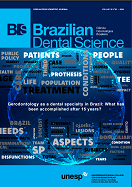Influence of composite resin volume and C-factor on the polymerization shrinkage stress
DOI:
https://doi.org/10.14295/bds.2016.v19i2.1257Abstract
Objective: Composite polymerization shrinkage
stress is an inherent process of chemical and light
composite resin activation. Consequently, this fact has
been associated to potential clinical problems. The
aim of the present in vitro study was to evaluate the
volume and C-factor influence on chemical and lightcuring
composite resin polymerization shrinkage
stress, using a non-rigid method that thereby provides
lower stress values, causing a minimal deflection in
load cell. Materials and Methods: The contraction
forces of the Z-250 and Concise composite resins
during polymerization were recorded in an UTM in
two experiments. In the first experiment, the Z-250
composite was inserted beetwen two rectangular
steel plates (6.0 x 2.0 mm), varyng the resin volumes
and C-factors, in a single increment, polymerized for
20 s and the forces generated were recorded for 120
s. In the second experiment, a pair of rectangular steel
plates (3x2mm) and two square steel plates (2x2mm),
with varied heights (2; 3 mm, respectively), were
used to determine the C-factor (0.6; 0.3) influence.
Results: The polymerized Z-250 results showed that
the volume variations, independent of the C-factor,
had a direct influence on the shrinkage stress,
different from the Concise, which was influenced by
the C-factor. Conclusion: The present study showed
that a higher volume of composite resins determines
an increase in the shrinkage stress of light-curing
composites.
Keywords
C-factor. Composite resin. Polymerization. Shrinkage
stress.
Downloads
Downloads
Additional Files
Published
How to Cite
Issue
Section
License
Brazilian Dental Science uses the Creative Commons (CC-BY 4.0) license, thus preserving the integrity of articles in an open access environment. The journal allows the author to retain publishing rights without restrictions.
=================




























